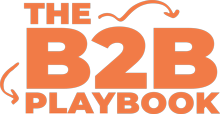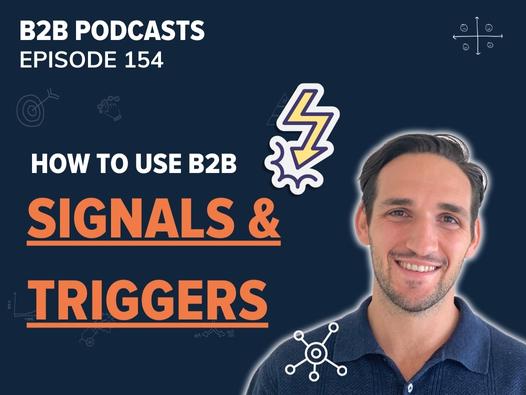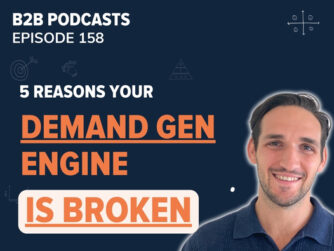Triggers and signals are all the rage in B2B marketing at the moment. We have website visitor identification companies like RB2B!, Clearbit, and Dealfront making plenty of noise. We have intent data vendors trying to sell you lists of people more likely to be ‘in-market’.
They sell the dream of being able to deliver the perfect message, to the right person, at the right moment. Sounds like magic, right?
But without a real understanding of these triggers, signals, and how to use them – they’re more likely to be just noise for your go-to-market team.
Today we’re going to cover:
- What triggers and signals are
- How to identify the right triggers for your business
- How to implement them effectively
- How to use them in a way that drives results
As per usual, you can watch, listen to or read the episode on triggers and signals below!
Listen To The Episode
Watch The Episode
Understanding B2B Triggers and Signals
Companies are splashing cash on technology that can reveal triggers and signals to try and predict when sales should reach out to the prospect. The reason for this is they want to try and accelerate demand with companies who are more likely ready to buy.
Typically a signal will indicate where a prospect may be at in their buying journey. Examples of ‘signals’ may include things like:
- Leads generated from eBook downloads
- Third party signals from BOMBORA, Capterra, or TrustRadius
- MQA scoring from ABM platforms
- Website deanonymization from Clearbit, RB2B!, Dealfront or Factors.ai
- Signals from LinkedIn Sales Navigator
This is not an exhaustive list. This is just an idea of different datapoints you could look at to try and determine if someone is more likely to be ‘in-market’ for your product or service.
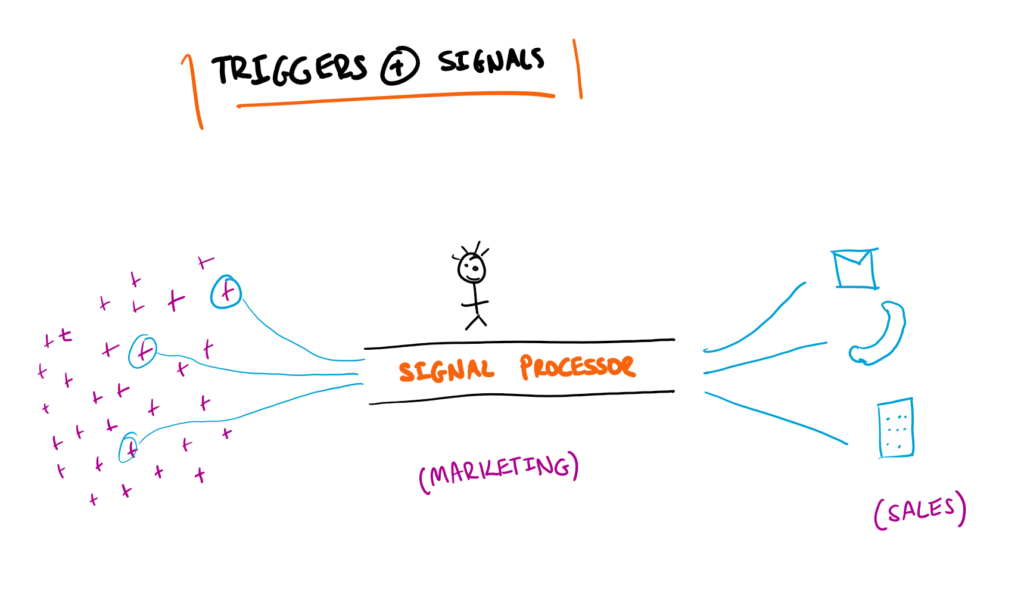
Part of marketing’s job is to process all of these different signals and triggers, and figure out the actions that need to be taken by sales and marketing based on the information you have. We can’t just hand over every signal we get to sales, or you’re asking them to find a needle in a haystack.
Common Misconceptions About B2B Triggers
Many marketers think that B2B triggers are a recent innovation, a product of the latest marketing technology trends. But the truth is, triggers are far from new. They’re rooted in fundamental go-to-market principles that have been around for decades — it’s just that the tools and techniques we use to identify them have evolved.
Triggers & Signals Are Nothing New
Prior to the rise of these digital platforms, BDRs would literally comb through newspapers and trade publications to find any hint of a change that might signal a buying opportunity — a company announcing new hires, an expansion, or even a recent round of funding.

These activities were their way of uncovering triggers — moments when a company might need new tools, services, or partnerships to support its growth. The difference today is that we have more sophisticated data sources and technology platforms to automate this process. Instead of scanning newspapers, we’re looking at intent data, website visitor data, social media mentions, and online behaviour patterns to find those same signals.
Stop Obsessing With Technology
With so much data at our fingertips, marketers trend towards an over-reliance on technology to find and act on triggers. They become too focused on the platforms, data points, and signals themselves without asking if these indicators are genuinely relevant or meaningful.
For example, they may get caught up in analysing every website visit or click without considering the context. As a result, they may overlook the bigger picture — the actual intent behind those actions. If someone visits a website page of ours around demand generation and, and perhaps our guide to defining demand generation, I can see that through Clearbit. I might even get their personal LinkedIn from RB2B! That doesn’t necessarily mean they want our demand generation services.
Think back to what data is actually relevant.
Not All Signals and Triggers Are Equal
Not all signals are equal; some may be stronger indicators of intent, while others may just be noise. It’s up to the marketer to track the signal and the action taken off the back of it to see if it had a positive impact.
For example:
- Signal: company that is in our ICP visits our pricing page
- Action: sales reach out with a soft touch to offer helpful resources
Based on that signal and action taken, how many turned into productive conversations? How much pipeline eventuated from it? If there’s a strong correlation between the signal, action, and positive outcome – then it’s worth continuing to do.
If we’re not evaluating our use of signals and actions, then all we’re doing is shovelling more crappy leads onto sales.
Effective Implementation of B2B Triggers
Okay now we’re familiar with what B2B triggers and signals are, let’s look at the right way to implement them.
Step 1 – Start with Customer Interviews
To know what triggers and signals to focus on, you need to really understand first what drives your best customers to take action in the first place. It’s easy to get caught up in data points and automated signals, but nothing beats hearing directly from your customers.
Conduct customer interviews to find out what actually triggered their search in the first place. You’ll start to uncover the real-life events or pain points that led them to seek out your solution.
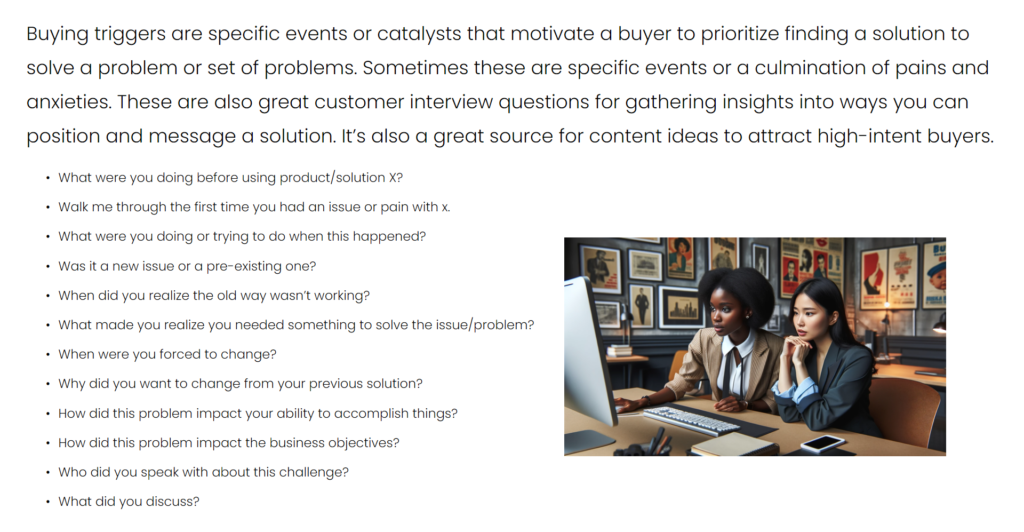
Ryan Paul Gibson has an amazing list of questions to ask your customers to try and uncover these buying triggers. You can check out the full article here.
Rather than going to these platforms first and seeing what signals are available and picking them, what we should do instead is speak to our best customers and find you what actually triggered their search in the first place. And then you can try and match those signals to the databases and platforms that actually have those.
Step 2 – Align Triggers with Customer Journey
Once you’ve gathered insights from your customers, the next step is to align those triggers with the stages of the customer journey. Different triggers matter at different points — a signal that indicates initial interest won’t necessarily be the same one that signals readiness to buy.
We love to map our signals to the 5 Stages of Awareness.

The action you take from someone that is clearly aware of your product won’t necessarily work for someone who is only ‘problem aware’.
For example, if someone is browsing our article on ‘what is demand generation‘, they’re far less likely to be receptive to me telling them about our demand generation course.
They’re more likely to just be ‘problem aware’, and much earlier on in their journey. So the action we might take may include:
- adding our ICP from the company browsing as a personal connection on LinkedIn to expose them to our organic content
- adding them to a remarketing pool
- soft outreach to see if they’re looking for any particular resources on Demand Generation, and offering to guide them to the right ones
But if they’re visiting our Demand Generation Course page, and they’re a subscriber to our newsletter and they fit our ICP – there’s a good chance they’re further along in their journey, so we can tailor our outreach accordingly to be a bit more direct.
This is why it’s crucial that sales are across the ‘helpful content’ that marketing are creating so they can be consultative to those who are not yet ready to buy. That way if they do speak to a prospect who isn’t ready to purchase yet, they can still be helpful and build a relationship – which may result in future pipeline when the prospect is ready to buy.
Step 3 – Test and Measure Trigger Effectiveness
As mentioned above, you need to test and measure the effectiveness of the triggers you’re acting on and the actions you’re taking from them. This will help you refine your approach at each stage in the buying journey.
Next Level Tip: Why You Should Be Cataloguing The Market
You can use these triggers to help you pull a list of companies and identify companies that are more likely to be in-market. But there’s a way to actually find out if someone is actually in-market or not – and this information isn’t available in some fancy platform.
You can actually gather this data by using an old-school technique that friend of the podcast Adem Manderovic showed me, called ‘cataloguing the market’. Cataloguing the market is effectively calling up that list of your ICP and surveying them to find out:
- Who they’re currently with to solve problem X
- What the love/hate about it
- What they pay
- When the come off contract
- Getting permission to circle back when you go to tender
This now gives you a list of your ICP, and who is in-market. This obviously helps us allocate our limited time, budget and resources as a go-to-market function.
You can read more about cataloguing the market and how to do it here.
Next Steps and Action Points
B2B triggers and signals can be a great tool for trying to accelerate demand and take a relationship to the next level, but their effectiveness lies in how you implement them. Be selective about the signals you act on, and always make sure it’s informed by first hand customer research – not just whatever data is available in the platform you’ve subscribed to!
Here’s action steps to take to execute this:
- Conduct customer interviews to identify relevant triggers
- Map triggers to your customer journey
- Catalogue the market to understand who is in-market vs out
- Test and measure the effectiveness of different triggers
- Integrate triggers into your nurture strategy
- Continuously refine your approach based on results.
Identifying and acting on triggers and signals is of course part of our Demand Generation Course, The B2B Incubator. See what marketers are saying about it here.
